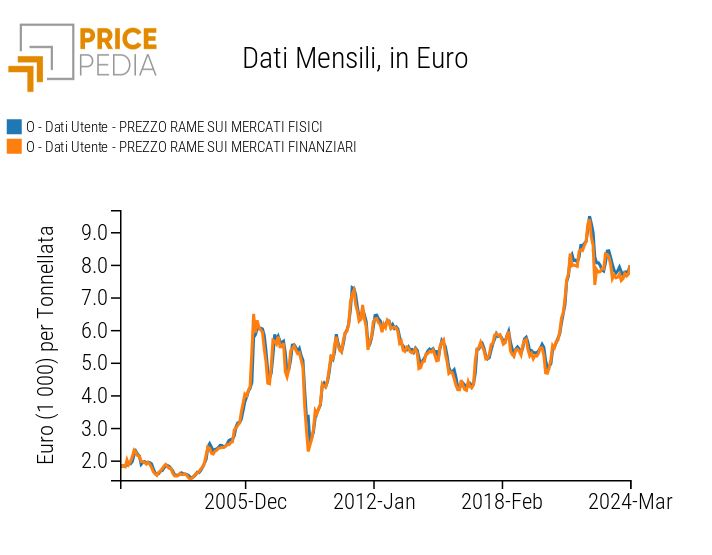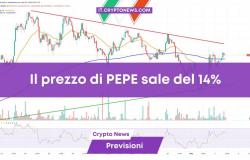The copper market, together with the oil market, are the two commodity markets whose price is formed day after day on the global financial market. Copper is listed on three different exchanges: the London Metal Exchange (LME), the Shanghai Futures Exchange (SHFE) and the Chicago Mercantile Exchange (CME). Thanks to sophisticated arbitrage operations by specialized operators, there is an almost perfect alignment of copper prices between these platforms, despite regional differences in supply and demand. Graph 1, which follows, gives an account of this alignment between the three different financial prices.
Price of copper cathodes (dollars/ton)
| Chart 1: comparison between 3 financial markets | Chart 2: Comparison of 3 regional physical markets |
The existence of a single global financial price of copper has important effects on the physical prices of the various world economic areas.
In theory, the price of a commodity should be determined by the intersection of supply and demand in the physical market and influence the financial market so that prices tend to converge to the physical price on the delivery date. However, the copper market deviates from this pattern. In fact, if it respected it, financial prices would have to record potentially different prices between the different exchanges, determined by the regional prices of the sub-state. Conversely, the opposite happens. The convergence of the three financial prices translates into a perfect convergence of the physical prices of copper in the different markets, regardless of the different supply and demand conditions that may characterize them.
Graph 2, above, presents the prices of copper cathodes on the US, EU and Chinese physical markets. The substantial alignment of these three prices is also evident.
A further element of great interest is the correspondence between the average price of copper quoted on the three financial markets (LME, SHFE, CME) and the average of the physical price of copper in the US, EU and Chinese markets. The following graph compares these two average prices, highlighting the high uniformity.
Price of copper cathodes on the financial and physical markets

The empirical analysis therefore demonstrates the existence of a single world copper market that establishes a single global price, applicable to both financial and physical markets. Considering that for over a quarter of a century the supply and demand conditions in the physical markets of the USA, EU and China have hardly been so similar as to generate a single world price through the supply and demand mechanism alone, it can be deduced that prices are necessarily physical ones followed by financial ones. This process suggests that the price of copper is largely determined in financial markets, reflecting investors’ expectations and strategies rather than immediate physical market conditions.
An alternative measure of supply and demand conditions
The “financial” nature of the single global price of copper makes it opaque with respect to the current supply and demand conditions of the various regional physical markets.
However, information on the conditions of different markets can be obtained by analyzing the prices of products upstream (copper ore and scrap) and downstream (semi-finished copper products) of the copper supply chain. The prices of upstream and downstream products tend, in fact, to be less affected, compared to cathodes, by financial prices and more by the supply and demand conditions of the various physical markets.
Prices of copper ore and scrap
The following table shows the prices of copper ores (first two rows) and copper scrap (last rows) recorded by the import flows of the EU and China. The central line shows, for comparison, the EU price of copper cathodes (which we have seen coincides with the single world price).
Price of copper ore and scrap in the world (dollars/tons)

From the analysis of this data it is possible to derive a signal of greater tensions between supply and demand in China during 2021 and part of 2022, corresponding to the peak values recorded by the price of copper. In the subsequent medium periods, the market progressively rebalanced, with a greater alignment between supply and demand on the EU market and especially on the Chinese market. If we consider the prices of minerals and scrap in China and the EU, compared to an aligned price in 2019, prices in China have, in fact, increased at greater rates in the two-year period 2020-2021, signaling greater market tension in this area. They subsequently decreased significantly against a slight growth between 2022 and 2024 in the corresponding prices in the EU.
The prices of some semi-finished copper products
The following table shows the prices of some semi-finished copper products, traded both on the EU market and on the US and Chinese markets.
Price of semi-finished copper products in the world (dollars/tons)

In this case the maximum price for all products is recorded in 2022, consistent with the existence of a time delay between the changes in the price of copper and those in the prices of its semi-finished products.
Even in the case of semi-finished products, in the 2021-2022 phase of price increases, the most intense variations were recorded on the Chinese market and, partly, on the American market. In the subsequent phase of market rebalancing, decreases were recorded in China, while in Europe and partially in the United States, prices did not decrease, but increased slightly even in more recent years.
The overall analysis of price dynamics
The analysis of the dynamics of commodity prices upstream and downstream of copper cathodes indicates sufficiently clearly that the physical market in which the most accentuated changes in supply and demand conditions occurred was the Chinese market, with an excess of application in the two-year period 2021-2022, progressively returned in the following period.
Conclusions
Copper, like oil, is characterized by the existence of a single global price determined by financial markets, to which the price of copper cathodes on physical markets aligns quickly and perfectly.
The analysis of the dynamics of physical prices upstream and downstream of the copper cathode indicates the Chinese market as the one in which the imbalances between supply and demand have been strongest, determining prices from which it is possible to extract signals on the historical evolution of conditions of abundance or physical scarcity of the metal.
Given the larger size and high degree of competition of the Chinese market, it is likely that in the future the most intense price variations on physical markets will be recorded in China, suggesting specific monitoring of Chinese prices upstream and downstream of the copper supply chain. This information, together with the single price determined by the financial markets, will be able to complete the picture of the situation on the world copper market.
Tags: Minerals metals semifinished products case copper









